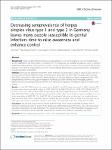Decreasing seroprevalence of herpes simplex virus type 1 and type 2 in Germany leaves many people susceptible to genital infection: time to raise awareness and enhance control
Korr, Gerit
Thamm, Michael
Czogiel, Irina
Poethko-Mueller, Christina
Bremer, Viviane
Jansen, Klaus
Background: Herpes simplex infections (HSV1/2) are characterized by recurrent symptoms, a risk of neonatal herpes, and the facilitation of HIV transmission. In Germany, HSV1/2 infections are not notifiable and data are scarce. A previous study found higher HSV1/2 seroprevalences in women in East Germany than in women in West Germany. We assessed changes in the HSV1/2 seroprevalences over time and investigated determinants associated with HSV1/2 seropositivity to guide prevention and control. Methods: The study was based on the German Health Interview and Examination Survey for Adults (DEGS; 2008–2011) and the German National Health Interview and Examination Survey (GNHIES; 1997–1999). We tested serum samples from DEGS participants for HSV1 and HSV2 immunoglobulin G. We used Pearson’s χ2 test to compare the HSV1/HSV2 seroprevalences in terms of sex, age, and region of residence (East/West Germany) and investigated potential determinants by calculating prevalence ratios (PR) with log-binomial regression. All statistical analyses included survey weights. Results: In total, 6627 DEGS participants were tested for HSV1, and 5013 were also tested for HSV2. Overall, HSV1 seroprevalence decreased significantly from 1997–1999 (82.1%; 95%CI 80.6–83.6) to 2008–2011 (78.4%; 95%CI 77.8–79.7). In the same period, overall HSV2 seroprevalence decreased significantly from 13.3% (95%CI 11.9–14.9) to 9.6% (95%CI 8.6–10.8), notably in 18–24-year-old men (10.4 to 0%) in East Germany. Women were more likely than men to be seropositive for HSV1 (PR 1.1) or HSV2 (PR 1.6). A lower level of education, smoking, and not speaking German were associated with HSV1 in both sexes. Women of older age, who smoked, or had a history of abortion and men of older age or who had not attended a nursery school during childhood were more often seropositive for HSV2. Conclusion: The reduced seroprevalences of HSV1 and HSV2 leave more people susceptible to genital HSV1/2 infections. Practitioners should be aware of HSV infection as a differential diagnosis for genital ulcers. We recommend educational interventions to raise awareness of the sexual transmission route of HSV1/2, possible consequences, and prevention. Interventions should especially target pregnant women, their partners, and people at risk of HIV.
Dateien zu dieser Publikation
Keine Lizenzangabe

